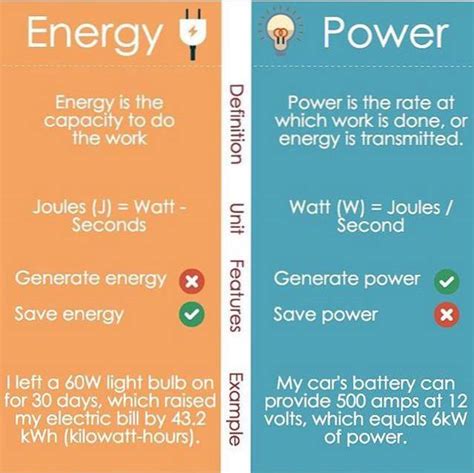The concepts of power and energy are often used interchangeably in everyday language, but in the context of physics and engineering, they have distinct meanings. Understanding the differences between power and energy is crucial for designing, optimizing, and operating various systems, from simple mechanical devices to complex electrical grids. In this article, we will delve into the definitions, units, and practical applications of power and energy, highlighting their differences and interrelationships.
Key Points
- Power refers to the rate at which energy is transferred or converted, typically measured in watts (W).
- Energy represents the capacity to do work, usually measured in joules (J) or other derived units such as kilowatt-hours (kWh).
- The distinction between power and energy is critical in various fields, including electrical engineering, mechanical engineering, and renewable energy systems.
- Power density and energy density are important considerations in the design of energy storage systems, such as batteries and supercapacitors.
- Efficiency and power factor are key parameters in the optimization of power systems, including transmission lines, generators, and motors.
Definitions and Units

Power is defined as the rate at which energy is transferred or converted from one form to another. It is typically measured in watts (W), which represents the amount of energy transferred per unit time. Energy, on the other hand, represents the capacity to do work, and it is usually measured in joules (J) or other derived units such as kilowatt-hours (kWh). The unit of energy is often context-dependent, with different units used in various fields, such as electrical engineering (kWh), mechanical engineering (J), or thermal engineering (British Thermal Units, BTU).
Power and Energy in Different Contexts
In electrical engineering, power is often expressed in terms of voltage and current, with the unit of power being the watt (W). The energy transferred through an electrical circuit is typically measured in kilowatt-hours (kWh). In contrast, mechanical engineering often deals with power in terms of torque and rotational speed, with energy measured in joules (J) or other units such as foot-pounds (ft-lb). The distinction between power and energy is critical in these contexts, as it directly affects the design and optimization of systems, including motors, generators, and transmission lines.
| Field | Power Unit | Energy Unit |
|---|---|---|
| Electrical Engineering | Watt (W) | Kilowatt-hour (kWh) |
| Mechanical Engineering | Watt (W) | Joule (J) or Foot-pound (ft-lb) |
| Thermal Engineering | Watt (W) | British Thermal Unit (BTU) |

Practical Applications and Interrelationships

The interplay between power and energy is critical in various practical applications, including energy storage systems, power generation, and transmission. For example, batteries are designed to store energy, but their power output is limited by their internal resistance and chemistry. Similarly, power plants generate power, but their energy output is dependent on the fuel source, efficiency, and operational hours. Understanding the relationships between power and energy is essential for optimizing system performance, reducing energy losses, and improving overall efficiency.
Power Density and Energy Density
Power density and energy density are important considerations in the design of energy storage systems, such as batteries and supercapacitors. Power density refers to the amount of power that can be delivered per unit volume or mass, while energy density represents the amount of energy stored per unit volume or mass. These parameters are critical in determining the suitability of energy storage systems for various applications, including electric vehicles, renewable energy systems, and consumer electronics.
In conclusion, the distinction between power and energy is fundamental to understanding various physical and engineering concepts. By recognizing the differences between these two related but distinct quantities, we can better design, optimize, and operate systems that rely on energy transfer and conversion. Whether in electrical engineering, mechanical engineering, or other fields, a deep understanding of power and energy is essential for advancing technological innovation and improving overall efficiency.
What is the main difference between power and energy?
+Power refers to the rate at which energy is transferred or converted, while energy represents the capacity to do work.
How are power and energy measured in different contexts?
+Power and energy are measured in different units depending on the context, such as watts (W) and kilowatt-hours (kWh) in electrical engineering, or joules (J) and foot-pounds (ft-lb) in mechanical engineering.
Why is understanding power and energy important in practical applications?
+Understanding power and energy is crucial for optimizing system performance, reducing energy losses, and improving overall efficiency in various applications, including energy storage systems, power generation, and transmission.
Meta Description: Discover the fundamental differences between power and energy, and how they impact various engineering and technological applications. Learn about the distinct units, practical considerations, and interrelationships between these two critical quantities. (147 characters)



